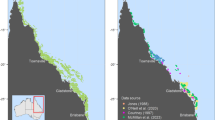Abstract
Lemming populations are generally characterised by their cyclic nature, yet empirical data to support this are lacking for most species, largely because of the time and expense necessary to collect long-term population data. In this study we use the relative frequency of yearly willow scarring by lemmings as an index of lemming abundance, allowing us to plot population changes over a 34-year period. Scars were collected from 18 sites in Arctic North America separated by 2–1,647 km to investigate local synchrony among separate populations. Over the period studied, populations at all 18 sites showed large fluctuations but there was no regular periodicity to the patterns of population change. Over all possible combinations of pairs of sites, only sites that were geographically connected and close (<6 km) showed significant synchrony in fluctuations. The populations studied may not even be cyclic, at least for the time period 1960 to 1994, and although fluctuating, randomisation tests could not reject the null hypothesis of random fluctuations. These data have implications for the testing of hypotheses regarding lemming cycles and highlight the need for long-term trapping data to characterise the lemming cycle.
Similar content being viewed by others
Author information
Authors and Affiliations
Additional information
Electronic Publication
Rights and permissions
About this article
Cite this article
Predavec, M., Krebs, C., Danell, K. et al. Cycles and synchrony in the Collared Lemming (Dicrostonyx groenlandicus) in Arctic North America. Oecologia 126, 216–224 (2001). https://doi.org/10.1007/s004420000516
Received:
Accepted:
Published:
Issue Date:
DOI: https://doi.org/10.1007/s004420000516




